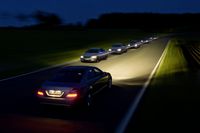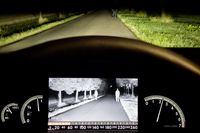New Headlamp And Night-View Systems: Adaptive Highbeam Assist Selects The Optimum Light Settings Automatically
LEIPZIG – November 12, 2008: Driving a car at night will be even safer in future. Mercedes-Benz is unveiling an innovative system which adjusts the range of the headlamps automatically based on the distance to oncoming vehicles or moving vehicles in front with their lights on. Consequently, the best possible headlamp range is always selected, allowing the driver to see the course of the road, pedestrians or danger spots at an earlier stage. From spring 2009, the new E-Class and the S-Class will feature the world's most powerful headlamp technology in the shape of the Intelligent Light System and Adaptive Highbeam Assist. What's more, Mercedes-Benz has further developed the tried-and-tested Night View Assist system, which illuminates the road ahead of the vehicle with non-reflective infrared light. As soon as the system detects pedestrians up ahead, they are highlighted on the display in the cockpit.
In contrast to conventional systems, which merely switch between low beam and high beam, the new Adaptive Highbeam Assist system adapts itself in line with the current conditions on the road, controlling the light distribution as the situation allows. The low-beam range can therefore be increased from 65 to up to 300 metres – without dazzling other motorists. If the system detects oncoming vehicles or vehicles in front, it adapts the headlamp range continuously, based on the distance to these vehicles, so that the cone of light emitted by the headlamps ends before it reaches these vehicles. In addition, Adaptive Highbeam Assist takes into account the steering angle in order to dim the headlamps on tight bends. If the road ahead is clear, the system switches to high beam with a minimum of fuss.
Realistic tests confirm that motorists who use Adaptive Highbeam Assist are safer on the road in the dark: dummies placed at the side of the road to simulate pedestrians were detected from a distance of around 260 metres – around 150 metres earlier than is the case when conventional low beam is used – despite the presence of oncoming traffic. The new Mercedes assistance system therefore offers more than double the safety at night.
What's more, the system relieves driver stress as there is no longer any need to repeatedly flick the stalk on the steering wheel. So the driver can concentrate more on actually driving the car. Once activated, Adaptive Highbeam Assist always provides the best possible headlamp range.
Studies have shown that high beam is currently only switched on for around eight percent of each night journey on average.
Data transfer every 40 milliseconds
The newly developed
Mercedes technology is based on a camera, located on the inside of the
windscreen, which monitors the traffic situation in front of the car.
Thanks to an intelligent image-processing algorithm, the camera is able to
detect other vehicles and the distance to them. The range of the
variable-control bi-xenon headlamps is set based on these findings and
adapted continuously depending on the distance to the vehicle in front or
the oncoming traffic. The system operates at lightning speed, sending new
data to the headlamps every 40 milliseconds. Adaptive Highbeam Assist is
ready to act at speeds above 55 km/h and operates autonomously once the
driver has moved the rotary light switch to the "Auto" position and
selected high beam using the multifunction stalk on the steering wheel.
Intelligent Light System increases headlamp range by 50 metres when
driving on the motorway
Mercedes-Benz will combine this new development
with the Intelligent Light System, which offers five different bi-xenon
light functions, each of which is suited to typical driving or weather
conditions:
The light system is based on powerful bi-xenon headlamps. These are variably controllable, and are networked with other electronic control units from which the headlamps obtain information about the current driving situation and distribute their beam patterns accordingly. The familiar low-beam headlamps are replaced by the new country mode, which illuminates the driver’s-side edge of the road more widely and brightly than before. In the dark, this enables the driver to appraise the situation and respond more rapidly when other road users cross their path.
Motorway mode, which comes on automatically when driving above 90 km/h, increases the driver’s range of vision by up to 60 per cent. This lighting function is activated in two stages: the Intelligent Light System first increases the output of the bi-xenon bulbs from 35 to 38 watts, thereby increasing the light intensity and providing noticeably better illumination of the road ahead and the side verges. The second stage of motorway mode is triggered at 110 km/h, when the beam of the bi-xenon module on the driver’s side is elevated slightly. Motorway mode has a range of around 120 metres, and the driver is able to see about 50 metres further at the centre of this cone of light than with conventional low-beam headlamps.
With the likewise enhanced fog lamps, Mercedes-Benz improves driver orientation when visibility is poor. The new lighting function is activated at speeds below 70 km/h, as soon as the rear fog lamp is switched on. The variable headlamp technology incorporated in the Intelligent Light System makes it possible to pivot the bi-xenon headlamp on the driver’s side outwards by eight degrees, while lowering its beam of light at the same time. This illuminates the inner half of the road more brightly and reduces the degree of glare from light reflected back by the fog. The Intelligent Light System also includes the active light and cornering light functions. These are switched on automatically: depending on the steering angle, yaw rate and vehicle speed, the active headlamps pivot sideways by up to 15 degrees in fractions of a second, thereby greatly improving road illumination. On an extended bend with a radius of 190 metres, the driver is able to see 25 metres further than with conventional low-beam headlamps thanks to this system. This function operates in both low-beam and high-beam mode.
The cornering light function improves safety at crossroads, at T-junctions and on tight bends. It is activated automatically when the driver operates the turn indicators or turns the steering wheel at a speed below 40 km/h. The fog lamps then swivel to illuminate the area diagonally in front of the vehicle for a distance of around 30 metres, with an angle of coverage of 65 degrees.
Night View Assist PLUS with new function for highlighting pedestrians
on the display
Mercedes-Benz will be offering Night View Assist
– available for the S-Class since 2005 – for the new E-Class.
The system uses infrared technology to enhance the driver's range of vision
in the dark: two separate headlamps illuminate the road with invisible,
non-reflective infrared light. A windscreen-mounted camera designed to pick
up precisely this type of light records what happens in front of the car
and sends the image to a display on the dashboard. The clear, needle-sharp
greyscale image that appears here shows the scene in front of the car,
allowing the driver to see pedestrians, cyclists or obstacles on the road
at an early stage. The Sindelfingen-based engineers have further developed
Night View Assist and, in future, will be equipping it with a special
pedestrian-detection function: as soon as the system detects pedestrians
ahead of the car, they are highlighted on the display to make it easier for
the driver to see them.




